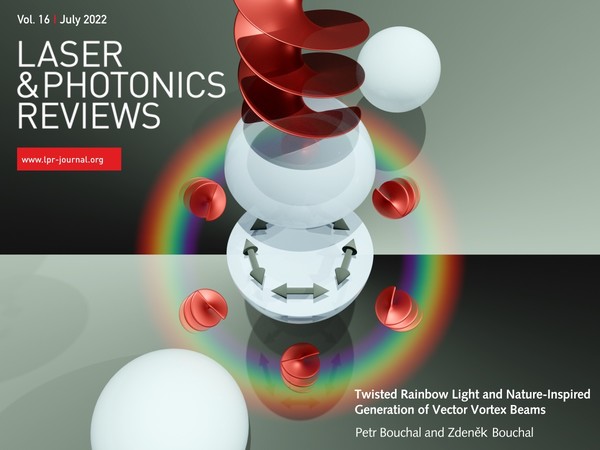During rainbow formation, the effect of water droplets on light is similar to the way light is controlled in laboratories using the most advanced technology. The direct analogy between the two optical mechanisms has been demonstrated by a joint project involving the UP Faculty of Science and the Central European Institute of Technology (CEITEC) at the Brno University of Technology. For the first time, scientists obtained a unique holographic image of a full-circle rainbow created in the laboratory, which made it possible for them to demonstrate the vortex twisting of light by falling water droplets. The results were published in the journal Laser & Photonics Reviews and featured on its cover.
In their experiments, researchers made a holographic imaging of rainbow light in order to reconstruct the phase images of primary and secondary rainbows. Then they focused on examining the effects in individual water droplets, which they replaced with glass microspheres in their experiments. “The primary incentive was to demonstrate the twisted phase of rainbow light, which is characteristic of optical vortices,” said Petr Bouchal from the Brno university, who initiated the rainbow research. "Already the initial stage of the research showed that solving such a task is challenging and is related to advanced control of light using metasurfaces, which is the focus of our project research," added Zdeněk Bouchal from the Department of Optics at the Faculty of Science.
Since the beginning of optics, light has been controlled by a targeted change in the optical path. An example is a converging lens, which slows down light passing through its centre more than light passing through the edge, where the glass is thinner. The lens thus changes the dynamic phase of the light, causing parallel rays behind the lens to become convergent. However using advanced technology, scientists have now found a way to steer light independently of the optical path it travels. They use the geometric phase of light, which was discovered for optics years ago by physicists S. Pancharatnam and Sir Michael Berry. “Controlling light with the use of the geometric phase has introduced entirely new possibilities, and the bulky glass lens can be replaced by a thin anisotropic layer, most often made up of liquid crystals or plasmonic metasurfaces,” added Petr Bouchal. “It is remarkable that the shaping of light through the geometric phase is used quite naturally in the formation of a rainbow. Although this atmospheric phenomenon has fascinated ancient civilisations and its physical nature has been studied by generations of optical scientists, the geometric phase change in water droplets has remained undiscovered,” said Zdeněk Bouchal.
Ever since the origin of ultrathin optics, anisotropic nanostructures have been capable of providing new optical functions. Examples include components that generate light vortices with a helical wavefront that resembles a spiral staircase. Such experiments require a helical change in the geometric phase of the light. This can be achieved by precise angular twisting of liquid crystal molecules or nanoantenna array metasurfaces. “Optical calculations have shown that an analogous geometric phase change occurs quite naturally in dielectric spheres, including water droplets, due to polarisation changes during the internal reflection of light. However, proving the spiral change of the geometric phase of rainbow light experimentally was a challenging task," added Petr Bouchal.
The spiral phase of the rainbow was reconstructed from time-resolved holograms recorded in incoherent white light reflected by a number of randomly falling water droplets created by a water spray. It was therefore necessary for the experiments to eliminate any effects associated with the change in the optical path of the light. “For this purpose, a special system using self-correcting light was designed, which also had to capture the rainbow light in an angular field of view greater than 120 degrees. The obtained quantitative phase images convincingly demonstrated the spiral phase distribution in both the primary and secondary rainbow in the shape of a full circle,” said Petr Bouchal, who designed and conducted the experiments.
In further research, the scientists focused on investigating the twisting of light in individual water droplets, which they replaced with glass spheres 5 to 10 micrometres in diameter. Polarised light vortices and vortex interference fields of high optical quality were then created using dielectric microspheres. “From a physics point of view, it was surprising that the glass spheres demonstrated the ability to convert the components of angular momentum of light. Light beams with circular polarisation carrying spin were converted into light vortices carrying orbital angular momentum in individual spheres. This effect has so far only been observed in nanostructures with spatially variable anisotropy,” said Zdeněk Bouchal.
These rainbow experiments have provided scientists with inspiration for designing new ways of controlling light, with wide potential of practical application. “The expanded insight into the mechanism of geometric phase modulation has led us to new methods for full anisotropy reconstruction which provide high spatial resolution and bring advances in biomedical and materials research,” concluded Petr Bouchal.
